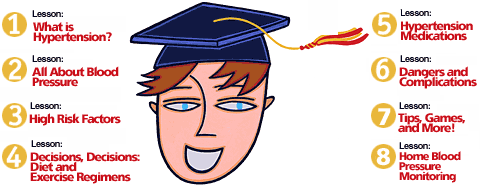



 |
|
|

|
|
Hypertension Lesson 2 - All About Blood Pressure 
Back to Hypertension Channel
By now you should know how important it is to keep tabs on your blood pressure. The best way to do this is to go see your doctor and have him or her check your blood pressure in the office with professional instruments. Chances are that if you've been to a doctor ever in your life, you've had this done. It's simple, easy and painless. It works like this: A blood pressure cuff called a sphygmomanometer (sfig-mo-ma-nom-e-ter — okay, so you didn't HAVE to know this — but I bet you never knew what that cuff-thing was called!) is wrapped around your upper arm. Your doctor then places a stethoscope against the skin on the inside of your elbow, over the artery. The cuff is inflated with a small hand pump to stop the blood flow through your artery for just a few moments. Next, a small valve is opened to slowly release the air from the cuff, and the doctor listens to hear your blood flow start up again. The reading on the blood pressure gauge (also known as a mercury indicator) when your doctor first starts hearing the "beat" of your blood passing through the artery is the systolic pressure. The last sound heard as more air is released from the cuff is the diastolic pressure. You can also take your blood pressure at home. There are many blood pressure kits on the market that give accurate information, and can help you stay on top of your cardiovascular health in between doctor check-ups. Most home kits don't use the traditional cuff and stethoscope. Instead, they are electronic cuffs that do most of the work for you. Watch our savvyHEALTH "Measuring Blood Pressure Tutorial" video to show you how to correctly take your pressure at home. Page 1 2 3 4 5 6 Copyright © 2000-2026 savvyHEALTH.com. All rights reserved.
|
|
|
|||||||||||||||||
|
About savvyHEALTH | Privacy | Feedback | Home
http://www.savvyHEALTH.com/
All contents copyright © 1999-2026 savvyHEALTH, Inc. All rights reserved.
This internet site provides information of a general nature and is
designed for educational purposes only. If you have any concerns about
your own health, you should always consult
with a physician or other healthcare professional. Please review the Terms of Use before using this site. Your use of the site indicates your agreement to be bound by the Terms of Use.
|
|